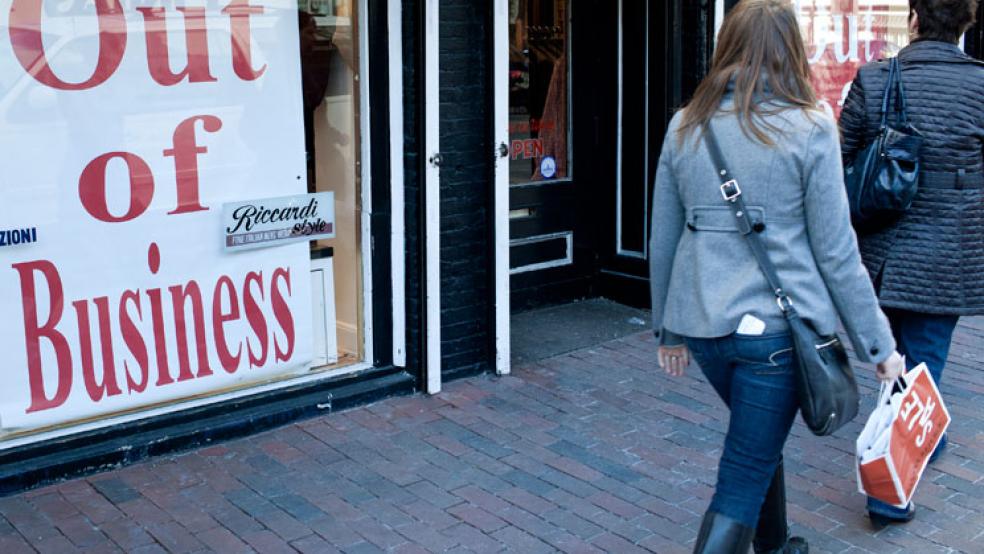The popular conception of the Great Recession explains that it stemmed from a financial shock. Housing prices stopped going up, and then Lehman Brothers fell, triggering paralysis in the credit markets. This spilled onto Main Street, and the effects still linger in terms of elevated unemployment and sluggish economic growth.
But this history of the recession can’t be right, say two economics professors who have studied the data. In their new book House of Debt, Amir Sufi of the University of Chicago and Atif Mian of Princeton point out that consumer purchases dropped sharply well before the September 2008 Lehman bankruptcy, and most deeply in places where home prices fell the most. They found that steeper declines in net worth — many homeowners were completely wiped out by falling home prices — led to far sharper reductions in consumer spending, and bigger job losses. But even those with no debt suffer when fire-sale foreclosures drop home prices, and lower overall demand spreads out across the country.
Related: Economy May Never Fully Recover from Crisis
By reviewing other economic downturns, Mian and Sufi discover two recurring features: a buildup of household debt before the crash, and an extreme decline in consumer spending afterward, as households cut back, hoarding money to pay off those scaled-up debts. The normal channels of fiscal and monetary policy have difficulty dealing with highly leveraged household balance sheets. House of Debt correlates these features of recessions, and really targets debt as the core problem, arguing that it needs to be restructured during crises and prevented during better times.
This critique — about the destructive power of debt and the need to forgive it — has in recent years come from far more radical circles, not from two economics professors trained in the classical tradition. “When we pitched the book, one publisher said, this is the intellectual justification for Occupy Wall Street,” said Professor Sufi in an interview. “We didn’t set out with that agenda. But one of the points we make is that the position we’re taking is not that radical if you look at history.”
Indeed, Sufi and Mian emphasize that the Great Recession response to debt forgiveness was a historic outlier. During the Panic of 1819, when falling commodity prices squeezed indebted farmers, state governments immediately put a moratorium on foreclosures, and Congress easily passed a debt-forgiveness law for farmers who had credit with the federal government.
In the Depression, the Home Owners Loan Corporation bought up failing mortgages and restructured them so borrowers could make cheaper payments. Even the code of Hammurabi, with its eye-for-an-eye view of justice, decrees that in lean times, a debtor can “wash his debt-tablet” and pay nothing for a year.
This actually helps debtors and creditors, mainly because it brings back the economy faster and reduces the vicious cycle of foreclosures lowering housing prices further. “When there’s a collapse in the economy, it’s a good idea to write down debt,” Sufi said.
Related: Two Housing Markets for the Two Americas
Why did the Bush and Obama administrations break with this tradition, steering aid to insolvent banks over indebted households? Sufi and Mian pinpoint the growing belief, which has taken hold among economists and policymakers that saving the banks equals saving the economy.
“The primary reason we wrote the book was because we believed this narrow banking view became the central focus of policy,” Sufi said. However, he argues, the idea of recapitalizing banks so they can resume lending falls apart upon scrutiny. “If you walk through it, we just think it doesn’t make sense. How can an economy with so much debt need more lending?”
A cultural bias against debt has crept into these debates too, blaming homeowners as “deadbeats” who bought “too much home” and ignored the risks (see the famous Rick Santelli rant). But while a 40 percent drop in home prices spares nobody, responsible or otherwise, this perspective also ignores a simple fact: There are two sides to a debt contract. “We blame the homeowner because they paid the price, but the only way that can happen is if a lender lends to the borrower,” Sufi said. “There is responsibility on both sides of the contract.”
Indeed, Sufi and Mian detail in the book how credit growth, particularly to low-income, high-risk households, fueled the housing bubble. Thanks to securitization, lenders could extend shaky credit and then pass off the risk to investors around the world, disconnecting themselves from any price drops. That’s before you get into how they ignored underwriting standards in a rush to lend, and fraudulently sold mortgage-backed securities without divulging the poor quality of the underlying loans. “Lenders should be held accountable for their actions,” Sufi said.
Because of the timing of the book release, Mian and Sufi have been drawn into a debate with Timothy Geithner, whose memoir Stress Test about the response to the financial crisis came out at the same time. Several reviews have contrasted House of Debt with Stress Test, and even Mian and Sufi have engaged, claiming that Geithner erred in downplaying the economic impact of relieving household debt. They called the failure to write down debt “the biggest policy mistake of the Great Recession.”
Related: Why Tim Geithner Is Wrong About the TARP Bailouts
House of Debt actually only makes one fleeting reference to Geithner, in somewhat positive terms. “The way it’s all happened made it more personal than I ever wanted it to be,” Sufi said. But the authors felt the debate was critical to future crisis responses. “When Geithner says there were political constraints, I can’t judge that. But when he says doing more wouldn’t have worked, now you’re in my area. And he’s just flat wrong about that.”
Rebalancing Risks in the Economy
Underlying the book, which draws on an impressive amount of zip-code level data, is a hidden story about inequality. When the rich take a greater share of income and wealth, it naturally dampens demand, because they don’t spend those extra dollars at the same rate as those of more modest means would. In that situation, Sufi says, “The only way to sustain demand is if the rich finance the consumption of the poor.” This gets linked through the financial system: Essentially, the rich invest in banks, and the poor borrow from them. So debt levels rise, as does the danger of deeper and more protracted downturns.
The way out of this box, Mian and Sufi contend, is to overhaul a financial system that is encouraged to offload risk on the most vulnerable members of society. “At the end of the day, the economy is risky,” Sufi said. “If banks are not bearing the risk, someone else is.”
This can be corrected in a number of ways. Reducing the preference for debt in the tax code and the subsidies we throw at debt financing would help; the mortgage interest deduction encourages homeowners to buy, and the favorability of debt over equity fosters leveraged buyouts and debt-fueled banking. Higher wages and broadly shared prosperity would eliminate some of the demand for debt to finance living standards. A cheap public option for higher education would depress student debt. More attractive savings vehicles could prevent the situation where the total net worth for a large chunk of Americans gets tied up in their homes.
Mian and Sufi add a novel solution: contingent debt contracts that share risk between borrowers and creditors. Tying student debt payments to a labor-market index, and tying mortgage payments to home prices, would automatically reduce principal in leaner times, while compensating the creditor with a share of the upside if prices rose.
This, the authors say, would reduce volatility, constrain bubbles, prevent foreclosure crises and lessen the damage of recessions. “The idea that financial firms should never take losses is indefensible,” they write. “We seek to encourage a financial system more equity-dependent and therefore able to absorb losses.”
The book presents a fascinating re-conception of how the financial system should operate to best benefit the public. It should inform policymakers as they design not only the optimal financial regulatory policy, but also their response to future catastrophes. As Sufi concludes, “If all we accomplish is that the next time something like this happens, people are guided not just by saving the banks, but by needing to address private debt, I feel like we would have accomplished what we set out to do.”
Top Reads from The Fiscal Times:
- Relentless Incompetence: Americans Are Giving Up on Obama
- Congress Is Blowing Our Best Chance to Rebuild America
- CBO Quietly Drops Forecast That Obamacare Will Cut the Deficit






